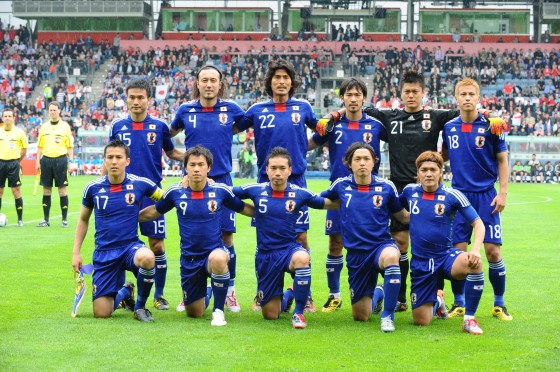What is a Japan House?―Strategies and techniques for cultural communication
Japan House was established in Sao Paulo, London and Los Angeles as a cultural hub to promote Japanese attractiveness towards the world. We [Gaiko editorial team] have asked Hara Kenya, the Chief Creative Director of Japan House, its significance and strategy.
— On August 24, 2018, Japan Houses in Los Angeles celebrated its grand opening. Following Japan House in Sao Paolo (April 2017) and London (June 2018).
Hara Kenya: Although we had partial openings in December 2017, now all are fully opened and we had an exciting opening ceremony too. But rather than focusing on initial success, we should see how many people visit over the course of a year, and how interested in Japan those visitors become. It is vital for us to continue with sustainable and compelling communication, making use of the special characteristics of all three sites, not just Los Angeles.
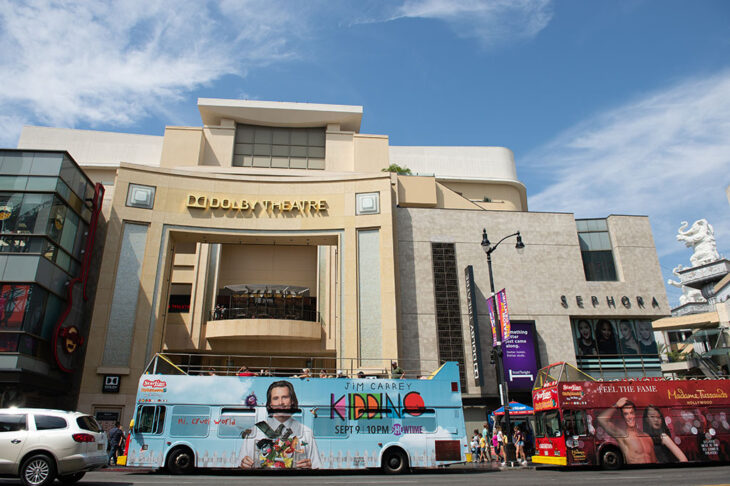
Japan House Los Angeles partially opened in December 2017 and began full operations on August 24, 2018.
Concept is “introducing striking discoveries about Japan to the world”
— What exactly is “compelling communication”?
Hara: Firstly, as a basic premise, we assume that most of the people in the world have never thought about Japan in their lives. When those people first encounter Japan, it’s vital, I think, that they are shocked at how little they know of Japan, then become interested.
— Even so, isn’t it difficult to communicate culture?
Hara: Yes, that’s right. That’s why, in the past, when Japanese culture has been introduced abroad, it has appeared in quite stereotypical forms. Staff wearing happi coats greet visitors, women wearing kimono play the koto harps, and groups of men beat on taiko drums. That kind of cultural introduction is certainly exotic; visitors will be wowed and intrigued, I think. It doesn’t go any further than the surprise of initial impressions, however; they don’t encounter the meaning and spirit hidden behind that, and most people quickly lose interest Instead, I’d like people to get a little deeper into Japanese culture: from high technology to tradition, and the aesthetics that lie behind those. They don’t need to understand immediately; I don’t want to organize culture in the form of initial impressions, but as a profound experience with a “Wow!” that deepens the more people learn. The Japan House concept is “introducing striking discoveries about Japan to the world.”
— Japan Houses have exhibition spaces, multi-purpose halls that can serve as theaters, and a restaurant/shop area.
Hara: It’s important to have a gallery where visitors can go around exhibitions, but the shops are just as important. Essentially, it is about avoiding stereotypes. It is no good just stocking popular souvenirs. At the London Japan House, we will be holding an exhibition of metalworking products from Tsubame-Sanjo. At the same time though, the products on sale in the shop will be everyday items: wonderful objects that display the spirit and techniques of monozukuri. I have seen a documentary where an artisan who wasn’t Japanese said that a Japanese kanejaku (carpenter’s square) was essential and that he would never go without it. Sabae in Fukui Prefecture receives orders from all over the world for its glasses-making technology. What is the history behind this Japanese monozukuri that’s admired around the world? If we convey that in a straightforward way, the world will notice. That’s why we have to choose the items on sale very carefully. Even if the price is a little high, they will make people around the world take notice and make the world richer. We want to present items like that; and doing that will help Japanese industries recover, I believe. We will take pride in that with screenings and exhibits that show off Japan’s superior points, from traditional technology to advanced technology, from high culture to subcultures. That’s the spirit behind what we do.
— How you sell and present these things is also important, isn’t it?
Hara: That’s right. For example, kyusu (small teapots for making green tea) are attractive, but that alone is not enough for them to sell. First, you need a succinct and easy to understand video that explains how to make green tea. You keep the tea leaves in a chazutsu tea caddy. Then you take some tea leaves using a chasaji teaspoon, transfer them to the kyusu, and pour on hot water. After pouring the tea into a Japanese teacup, the cup goes on a saucer, then both on a tray to be carried. If someone sees that whole series of actions, they’ll probably want to try making Japanese tea themselves. And they won’t just become interested in the kyusu, but also the caddy, teaspoon, the type of tea, tea bowl, and tray. It is important to carefully visualize what’s behind the products. We have made quite a few videos of that kind. One was how to use an oroshigane grater to grate daikon, wasabi, and yuzu. Another was how to wrap gifts in a furoshiki wrapping cloth. And another was how to use sake ware and pour sake into a sake cup. – It sounds like when people understand the series of actions, they become very interested. There are videos on the Japan House website too. Please do take a look.
Making use of the three cities’ special characteristics in the operation of each Japan House
— The three locations are each run in a distinct way, aren’t they?
Hara: The companies we commissioned, the architects, and the project managers were different, so of course some local differences emerge.
Sao Paolo was the first we opened. That opened in April 2017 with facilities designed by Kuma Kengo. We have borrowed half of some premises that belong to the Banco Bradesco, but the bank building was rather boring. So Kuma added a kind of hinoki cypress frame called jigoku-gumi to create a unique exterior. The interior was designed in collaboration with a Niigata Prefecture washi paper artisan, Kobayashi Yasuo. He made interior space dividers using translucent material of metal mesh that was coated with a layer of mulberry fibers in a similar way to making washi paper.
— The exhibitions are also unique, aren’t they?
Hara: To match the space, the exhibitions are also creative. The inaugural exhibition to celebrate the Sao Paolo opening, titled Bamboo, was themed on Japanese lifestyles and design. I found it enlightening too.
Half of the exhibition was planned by the Sao Paolo Japan House itself; the other half was made up of touring exhibitions, sought and selected from all over Japan. There are several touring exhibitions a year, each lasting around two months and visiting all three locations in turn.
The level of the touring exhibitions is high and they bring in visitors. For example, at the Futures of the Future exhibition by architect Fujimoto Sou there were unusual and surprising architectural models that used everyday objects. The Prototyping in Tokyo exhibition by industrial designer and University of Tokyo professor Yamanaka Shunji fused the use of cutting-edge processing technology with intricate and refined Japanese sensibility.
There was also an exhibition by the specialist paper distributor Takeo Co., which investigated the possibilities of paper as both advanced technology and a traditional material, and which included workshops.
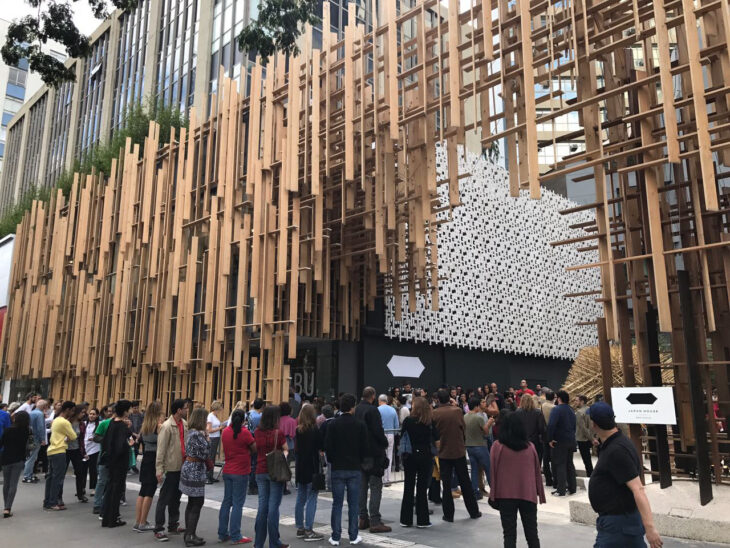
Japan House Sao Paolo, which opened in April, 2017. The distinctive facade produced by Kuma Kengo.
— It sounds like you can explore many different possibilities.
Hara: In the future, I hope talented young Japanese people will see Japan House as somewhere they can use and want to use — and that they will use it fully. I’d also very much like people from companies to use it as a place to present their own products. For example, we could definitely do a fun exhibition about Japanese toilets and I think it would attract attention.
— There have been over one million visitors to the Sao Paolo Japan House, haven’t there?
Hara: Initially, our target yearly visitor count was 140,000, so one million in the first year after opening is a happy surprise. For any exhibition there is an approximate and set number of visitors. This is blowing our own trumpet, but I feel like the Japan House has developed to be in the running for the first or second-ranking cultural location in Sao Paolo.
— After Sao Paolo, the London Japan House opened this June [in 2018], didn’t it?
Hara: First of all, the London Japan House has a great location. The Kensington High Street area is packed with museums and cultural facilities, such as the Victoria and Albert Museum and the Design Museum. It’s on a street where connoisseurs and communicators come and go.
The interior was designed by Katayama Masamichi. He has worked on many retail facilities, such as for UNIQLO, and the detailed craftsmanship of the retail space was as wonderful as his reputation suggested it would be. It is an old building with an art deco facade, but a circular elevator column rises through three floors from the lower ground floor, to ground floor, to first floor. A spiral staircase curls around this and is a strong axis for the whole facility. The lower ground floor has the gallery, hall and library. On the ground floor there is the shop. And on the first floor there is a sake bar and also a restaurant run by Shimizu Akira, a chef from the popular London restaurant Engawa.
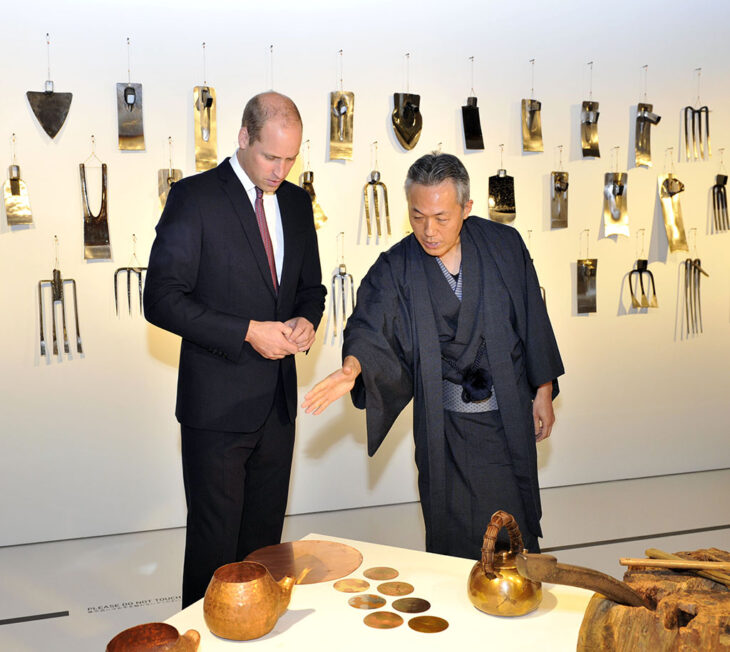
Prince William, Duke of Cambridge listens to an explanation by Tamagawa Motoyuki of Gyokusendo Co., Ltd. during the Japan House London exhibition, Biology of Metal: Metal Craftsmanship in Tsubame-Sanjo.
The exhibitions are coordinated by Simon Wright (Director of Programming at Japan House) who previously worked in communications at the Embassy of Japan in London, and who is also a Japan aficionado. He was the one who first thought of the Tsubame-Sanjo exhibition I mentioned earlier. The first exhibition was by Fujimoto Sou. After Tsubame-Sanjo came Takeo Co.’s “Subtle,” Yamanaka Shunji’s Prototyping in Tokyo, then an exhibition by manga artist Urasawa Naoki. We expect each of these to bring a different category of visitors.
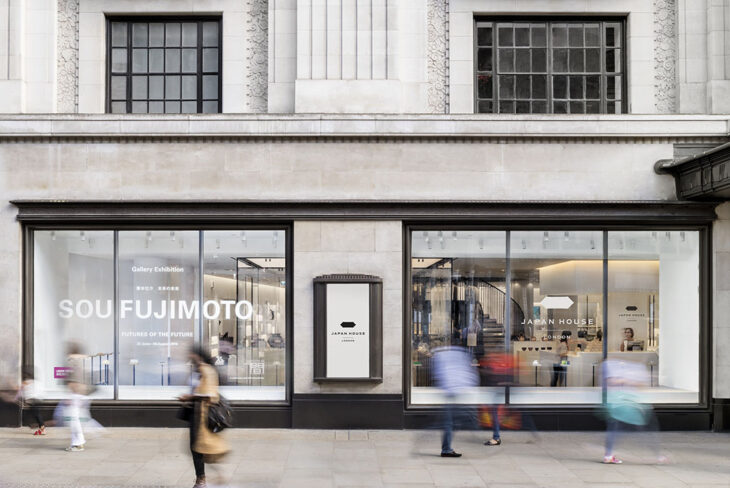
Japan House London opened on June 21, 2018.
— It’s now three months since Japan House opened. How has the reaction been?
Hara: Perhaps it’s down to the cultural location, but many visitors have responded to the contents of our communications and I sense that they are very receptive. We also exceeded our initial annual visitor target of 20,000 in two months.
To be honest, London was the one I was most worried about. There’s no shortage of Japan aficionados in London, so if the exhibition contents were weak or the product line-up was boring, they would go somewhere else. Japan House’s success or failure in the world information hub that is London has important meaning for predicting its future. But for now, I am relieved that we had a good start.
— Then in August, the Los Angeles Japan House opened fully.
Hara: The Los Angeles Japan House is in Hollywood. Since the area has lots of tourists, we needed some ingenuity to make exhibits comprehensible to walk-in visitors from tours. On the other hand, LA residents don’t often go to Hollywood. So for that very reason, I’d like to organize exhibitions that encourage them to make the effort to come to Japan House. We are working with an intent to change Hollywood through Japan House.
This August [in 2018] the restaurant, library and multi-purpose hall opened. Food operations are important, but there are around 1,000 Japanese restaurants in LA, so there was no point in opening a 1001st. For that reason, we set up a kitchen with equipment for preparing Japanese food and a location which looks over Hollywood, and which we make available to companies working in Japanese food. It is expensive for companies to get it all together and open a restaurant, so having rentable space makes it easy for them to use it.
How to think about the “results” of communication
— I see the importance of communicating Japanese culture and increasing the number of those who understand and appreciate Japan, but on the other hand, how do you measure those results? It’s difficult in some ways, isn’t it?
Hara: Since this is a government measure, we need to test results from various angles. But if we impatiently pursue “results,” I think this project will actually lose its value.
Territorial issues that are pressing historical problems for Japan are trivial events on the edge of Asia for other people in the world. I don’t like the term strategy, but if Japan does need strategy, the sharpest instrument it has is culture. Culture doesn’t obfuscate; it is the best and keenest strategy. As we link economy, culture and various other elements, how can we capture affection, empathy and respect for Japan? In other words, I believe we must think deeply about how to make culture a highly effective form of public diplomacy. On the other hand, culture is not a tool of politics. If Japan House’s activities are seen as propaganda, interest in and trust towards us will vanish. Instead, by drawing a line between us and such politics, Japan House will become more trusted and people will empathize with Japan in a deeper way. That seems like a roundabout method, but I think it’s the most effective.
— I hope it can lead to increased inbound tourism.
Hara: The government is working hard on inbound tourism. It’s increasing so quickly that the number of inbound tourists to Japan is now approaching 30 million per year. But this isn’t just a Japanese phenomenon. Inbound tourism is increasing all over the world and, compared to that trend, Japan actually lags behind right now. Even in laggard Japan, there’s potential for the number of tourists from overseas to grow to 40 million in 2020 and 80 million in 2030. I hope that Japan Houses in different locations can respond to this by sparking interest in Japan. Incidentally, 80 million is about the same number of inbound tourists that France currently gets.
— Can Japan House’s work be an opportunity for Japanese people to rediscover value in Japan too?
Hara: I think that’s true. Japanese people tend to underestimate Japan a little. There’s a need for opportunities for Japanese people themselves to learn how their culture and technology is amazing people around the world. For example, it would be fun if we could gradually do things like setting up Japan Houses in Tokyo’s international airports and having more sophisticated product sales.
Related article on Hara Kenya: Reassessing Post-3/11 Japan from An Aesthetic Perspective
https://www.japanpolicyforum.jp/culture/pt20111130172434.html
Translated from “Japan Hausu-tte nani?—Hasshin no senryaku to shuho (What is a Japan House?―Strategies and techniques for cultural communication),” Gaiko (Diplomacy), Vol. 55 Jul./Aug. 2019 pp. 24-29. (Courtesy of Toshi Shuppan) [October 2019]
Keywords
- Hara Kenya
- Japan House
- Japan House London
- Japan House Sao Paolo
- Japan House Los Angeles
- cultural communication
- monozukuri

